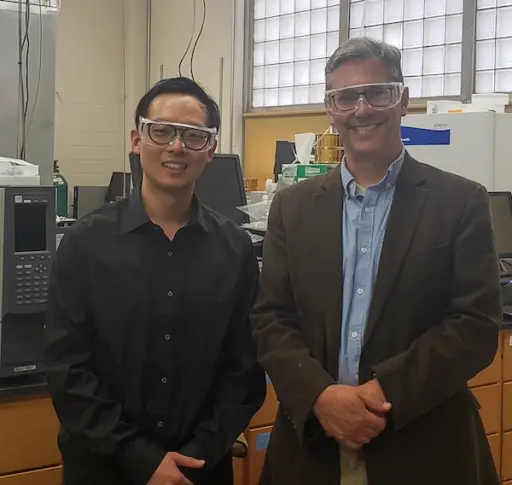A paper in the journal Green Chemistry led by postdoctoral researcher Houqian Li and George Huber, the Richard L. Antoine Professor in chemical and biological engineering at the University of Wisconsin-Madison, is a veritable “recyclopedia” that will provide researchers a valuable resource as they develop new techniques and strategies for recycling plastic waste.
The paper, which is over 100 pages long details the current state of the plastics recycling industry and includes primers on mechanical and chemical recycling techniques and other emerging technologies. It also includes discussions of landfills, emerging methods for sorting plastic waste, the chemical supply chain for plastics, economic analysis of the industry and many other aspects of the recycling process.
“On my first day in the lab, Professor Huber asked me if I would be interested in putting together a review paper about plastic recycling. I was like, ‘Wow that’s a pretty cool project.’ And it turned out not to be a review paper,” Li jokes. “I would say it’s more of a textbook or an encyclopedia!”
Li, who studies plastics pyrolysis, is first author on the paper, which includes 33 other co-authors. Many of those come from across UW-Madison in areas such as chemistry, civil and environmental engineering, mechanical engineering, biological systems engineering, as well as some of Huber and Li’s colleagues in chemical and biological engineering.
 Houqian Li and George Huber
Houqian Li and George Huber
In recent years, efforts to decarbonize the economy have highlighted the problem with waste plastics. Only about 10% of the 380 million tons of plastics produced each year is recycled globally, with 8% of those downcycled into less valuable materials. Only 2% of plastic is recycled into “virgin” feedstock, which is used for closed loop recycling.
That has driven strong interest in improving recycling techniques and developing new methods for transforming waste plastic back into useable, high-quality products. Huber, who is director of the National Science Foundation-funded multi-university Center for the Upcycling of Waste Plastics, says a lot of research has gone into designing plastics, but historically not as much attention has been paid to recycling. “There’s a whole complex science that goes into making any type of plastic material you look at, like a detergent bottle,” he says. “It’s designed to get the consumer to buy the product, not to optimize recycling.”
Craig Benson, a civil and environmental engineering professor emeritus who, with his research team, wrote the sections on the state of materials recovery facilities and landfills, says the review paper solves a major problem for the plastics research community. “You’ve got all these people coming into recycling, but they don’t necessarily have all the background yet,” he says. “They usually find a paper over here and a piece over there and end up with an incomplete picture. Review papers like this serve an important foundational role summarizing everything people have learned in the last 20 years. Having that knowledge in a broad variety of areas together in one spot is fantastic.”
Compared to paper, aluminum and glass, plastic is much more complicated to recycle. It cannot be simply melted down and remolded. That’s because plastic polymers, which are chiefly derived from petroleum or natural gas, come in dozens of varieties and contain a myriad of additives, including coloring agents, UV blockers, flame retardants, anti-static agents and others that are difficult to separate out. Other plastics, especially those used for food packaging, are made of multi-layer plastics, which also are not easy to separate.
The review paper lays out these issues and discusses emerging technologies for recycling. Among them are chemical recycling techniques under study at UW-Madison. STRAP (solvent-targeted recovery and precipitation) is a way to catalytically separate multilayer plastics, while pyrolysis is a technique in which waste plastic is broken down into a liquid oil using heat before plastic monomers and chemicals are recovered catalytically. Other emerging techniques included in the review include gasification, biocatalysis, glycolysis and many more.
Li, who solicited contributions to the paper, edited the draft, and wrote several of the chapters, says he learned quite a bit throughout the process; in particular, it helped him realize the power of pyrolysis, his field of study, especially when pyrolysis oil is upgraded into sustainable chemicals.
He hopes others will learn from the review as well. “When I was struggling with the 1,000 citations and references,” he says, “I thought about how beneficial this paper could be to our society. And when I thought about that, it gave me more energy to do all that work.”
Other UW-Madison authors include Professors Ive Hermans, Manos Mavrikakis, Tim Osswald and Victor M. Zavala; Associate Professor Reid C. Van Lehn; and Horacio A. Aguirre-Villegas, Sabrina Bradshaw, Son Dong, Soumika Gaddameedi, John E. Garcia, Min Soo Kim, Jiaze Ma, Lesli Mark, Konstantinos G. Papanikolaou, Kevin L. Sánchez-Rivera, Jiayang Wu and Panzheng Zhou.
Other authors include Robert D. Allen, Gregg T. Beckham and Julia B. Curley of the Renewable Resources and Enabling Sciences Center and the BOTTLE Consortium, National Renewable Energy Laboratory, Golden, Colorado; Xiangland Bai, Jessica L. Brown, Robert C. Brown, Olumide O. Olafasakin, Harish Radhakrishnan, Mark M. Wright, Victor S. Cecon, Greg W. Curtzwiler, Khairun N. Tumu and Keith L. Vorst of Iowa State University; and Marco Antonio Sanchez Castillo of Universidad Autónoma de San Luis Potosí, Mexico.